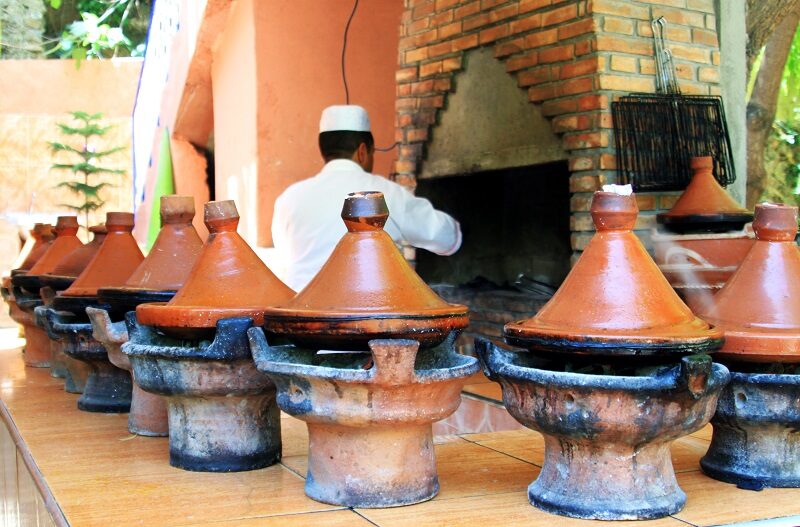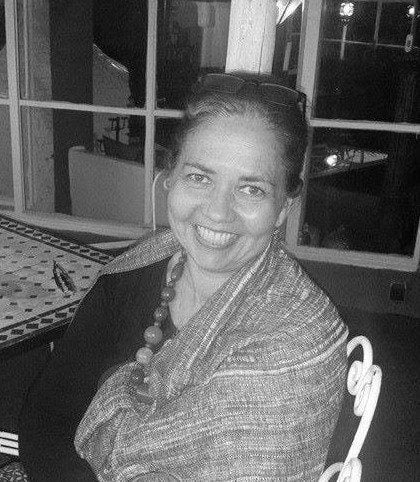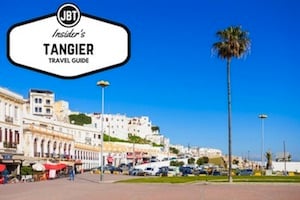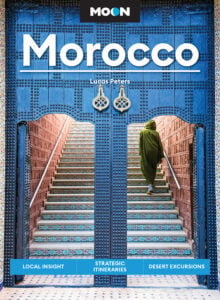Food in Morocco is steeped in tradition and culture. Few people outside of cities have clocks in Morocco, instead scheduling their days around the five calls to prayer and the daily meals that punctuate life. From mint tea to tajine, couscous to cookies here are a few basic guidelines that will give you some idea of what to expect.
The call to prayer starts the day at dawn and lends its rhythm to the day and the meals that follow. With an early start resonating from the nearest mosque, there will be time for some mint tea and bread depending on everyone’s work schedule, with the possibility of a more substantial breakfast a bit later in the day. With anytime being a good time for a glass of mint tea and a chat in Morocco, lunch is served at midday, with dinner usually being a late evening event. These rhythms are predictable and universally held across the country. What you can expect to find on a Moroccan table at any one of these meals is also not too hard to guess. Morocco has a long and proud culinary tradition, and families rarely stray far from the basics. Luckily, the basics are universally delicious.
Food in Morocco: What’s for breakfast?
The neighbourhood bread ovens fire up early in the morning to make sure that bread in some shape of form is on the table for breakfast. If a Moroccan home is without bread, something is deeply wrong. Bread, khobz, is the one true staple of Moroccan diets, and girls learn how to bake their family’s bread at an early age. While it might vary from family to family, most are circular flatbreads and are baked using whatever grains are grown locally. Breakfast usually includes bread with olive oil, olives and cumin, or for those with a sweet tooth, some honey or jam. Eggs will be on the breakfast menu at any local café, either fried or in a simple omelette. A cheese omelette is usually referring to the addition of a triangle of ‘La Vache Qui Rit’ or “Kiri” – brands of processed cheese found everywhere in Morocco.
A more traditional cheesy option, and usually served alongside the breakfast bread and olives, is a soft white Moroccan cheese, Jben (sj-ben) or Jben arabi. Originating in the Rif mountain area, this cheese is typically made from goat or cows milk. It is sold fresh at markets, and stands out because of its beautiful hand-plaited palm leaf packaging. There is also a supermarket version which is milder in flavour.
To wash down your khobz and jben, the other mainstay of the Moroccan diet, mint tea, is always on the breakfast menu. It is the national drink and revered as such. This isn’t any tea you’ve likely had before, though; Moroccan tea is brewed in a very certain way. Starting with gunpowder style green tea, masses of sugar and fresh sprigs of mint are added to the steeping brew, creating a syrupy-sweet concoction that is never far from any table. It is served with breakfasts and tea breaks, and as dessert after lunches and dinners. While visitors often struggle with the sugar content, Moroccans will be impressed if you take the tea as they do. It’s something to try at least once—if you have a real sweet tooth, you’ll feel right at home. If the sugar is too much too handle, practice your language skills and ask for – shwiya sukar – a little sugar.
Another breakfast dish that might take visitors by surprise is B’sarra (bis-aara), also referred to as Bisr if you are further north. This soup is a streetfood staple made from broadbeans, and is equally delicious for lunch if soup for breakfast isn’t your thing. Typically made for fisherman to have before setting sail in the morning and served with bread and lashings of olive oil and cumin, a bowl of b’sarra can keep you going for most of the day.

Food in Morocco: What’s for lunch?
Assuming your main meal is going to be in the evening, then a café style streetfood lunch might be on the menu. There will always be a selection of grilled or barbecued meat brochettes (kebabs), bread and fresh salads on offer at roadside and medina cafes. Step into one of the sandwich or snack bars, choose your filling from the display in the fridge (meat, fish, chicken, vegetable) and it will be cooked fresh and put in some bread along with a hefty portion of french fries before being wrapped in paper for you to takeaway or eat at a table outside.
If you are striding out into the sahara, keep an eye out for medfouna (med-foon-aa) affectionately called the berber pizza. Best described as similar to a calzone, it is a wood fired bread usually stuffed with a spiced lamb and onion mix. You are most likely to happen across this delicious snack in the south of the country.
Morocco has a coastline that stretches from the Mediterranean to the Atlantic, so if you find yourself soaking up the sunshine along the seafront, then grilled fish simply cooked over hot coals is always a good idea. Sardines fresh from the sea and hot off the grill are typically served with salt and lemon. You might also find mashrouk on the menu, sardines stuffed with chermoula (a spice mix made primarily with cilantro, paprika and cumin) and which, like most things, goes wonderfully with that fresh bread we keep mentioning, and some local olives.

Feeling peckish? Time for tea (again)
With the evening meal often being a late affair you might want to refuel mid-afternoon. Take time to sit down with that mint tea, or ring the changes with a coffee or a glass of freshly squeezed orange juice. There are plenty of treats and snacks on offer to fill a gap. Cookies come in all shapes and forms, and you will often see a cookie seller with his tray wandering through the medina. The most traditional of these is the Corne de Gazelle, a crescent shaped sweet cookie filled with an almond paste scented with orange water. Or you could be tempted by a more substantial Sfenj – a Moroccan doughnut – from a passing street vendor. Another snack, briouats (bree-ot) are perfect to grab on the go. With both sweet and savoury options, these are small pastries made with a filo like layers and come in a variety of fillings from chicken to fish to nuts and honey.

Food in Morocco: Whats for dinner?
With the last call to prayer usually being at around 9pm, dinner will often follow. Whether you have a main meal at midday or in the evening, at a restaurant or a private home you will be presented with repertoire of traditional Moroccan dishes that might sound similar, but all will have the regional and personal touches of the chef. What all Moroccan food does have in common is its regionality and its seasonality.
Tagine, tanjia, tagra are just a few of the dishes you might cross paths with on your travels through Morocco, and interestingly all of these names refer to the vessel as much as the dish.
The tagine (taj-sheen) is probably the best known and most common Moroccan dish on the menu. In this case the name comes from the conical clay pot in which it is cooked and served. Traditionally a tagine is a thick stew of vegetables, whatever may be on hand or in season, with a bit of meat added in the middle. The dish is served hot and presented in a single dish to the table of diners. Moroccan meals are a communal affair, and the tagine is shared from the single pot, with each diner keeping to their own ‘triangle’ of the dish. Rather than use spoons or forks, tagine is eaten with bread. Tearing a small piece off a larger slice, the idea is to use the bread to soak up some of the broth while also scooping up some of the vegetables and meat.
Tagine is often eaten for both dinner and lunch and is the standard meal within the Moroccan diet. The ingredients and options tend to vary regionally, with a seafood tagine clearly a coastal offering, with chicken or lamb on the menu as you go further inland. Slow-cooked chicken with green olives and lemons is arguably the classic, but be sure to try the more humble kefta variety where minced lamb or beef is rolled into balls, cooked in a tomato and onion sauce, and topped with an egg. It isn’t unusual to find a vegetable tagine on the menu making eating locally fairly easy for vegetarians.

Sharing center food-stage with the tagine in Morocco is couscous. When people think of Moroccan foods, couscous will generally be on the agenda. Moroccans are proud of their de-facto national dish, and are very particular about its preparation. Rather than boiling the dried couscous in a covered pot as is often done in North America, the couscous is placed into a steamer above a pot of boiling vegetables. The couscous is steamed this way for an hour or more, periodically fluffed by hand. It is at this point that a generous helping of preserved butter is added which adds a depth of flavor to the grain. When the couscous is ready, it is served in a single large plate, the vegetables and broth poured over the top. As with tagine, couscous is traditionally eaten by hand—a difficult skill for visitors to develop so you will invariably find cutlery close at hand. Because of the labor-intensive nature of its preparation, couscous is seen more as a special occasion dish than a daily staple. Many families have couscous each Friday (the holy day), as well as in honor of guests or special events.
While couscous and a tagine or two are probably the most well known and commonly available dishes, they are by no means the only options.
If you are in Marrakesh keep an eye out for mechoui (mesh-wee),a slow roasted lamb served best with bread (of course) and salt and cumin. Follow your nose to Mechoui Alley, where quite frankly, the clue is in the name. You will find an assortment of small family owned shops, all with underground clay pits for slow roasting whole lamb. Around lunch time the meat is cooked to perfection and can be bought by the weight – along with some bread and mint tea…
Another Marrakesh speciality is the tanjia. In this case the name refers to the clay urns in which a meat and vegetable stew is slow cooked in the embers of the hammam fires. A bit of a side-gig for the hammam staff while they keep the fires burning to heat the water.
Staying inland, Rfissa, an aromatic lentil, chicken and bread dish, is another dish you might come across, although this is less likely to be standard fare on a menu and more likely to be served if you are invited to eat in someones home. This chicken stew is flavoured with fenugreek, and served over the traditinal msemmem (or, if you are in the north rghaif) which is a flaky pancake like bread.
Moving north, you might find tagra being served as dish of the day. Again, referring to the bowl it is cooked in as well as the contents, a tagra is a wide shallow ceramic bowl traditionally used for baking fish dishes. Fresh fish is cooked with vegetables, tomatoes, olives, lemons and herbs. Essentially the tagra is to Morocco what the bouillabaisse is to France.
The mix of sweet and savoury is another trademark Moroccan taste with a lot of the main dishes having notes of cinammon and honey running through them. Meat tagines are often cooked with dried fruit like dates and prunes, adding that sweet undertone to the dish. B’stilla (bi- stee -ya), a sweet and savoury pie made with filo-like pastry, is the one you will see most often on the menu, especially if you are in Fez where it is something of a trademark dish. Traditionally made with pigeon, it is now more likely to be a chicken rendition cooked with almonds, cinammon and spices, and sprinkled with sugar.
Sfa(s-fa) is less likely to be on a restaurant menu and something you will probably only get to taste if you get to sample some homecooking. Again with cinammon and sugar, it is a sweet chicken and vermicelli pasta dish with a combination of sweet and savoury notes that might take some getting used to.
While some dishes are regional, others are distinctly national, and harira soup (har-eer-a) is undisputedly on the national menu. Available all year round, but particularly associated with Ramadan, this Moroccan staple is a comforting chickpea, tomato and lentil based soup traditionally thickened with eggs. It is one of those dishes that everyone is convinced their mother makes best.
A drink with dinner?
While Morocco is a Muslim country and a lot of cafes will not serve alchohol, many restaurants do, especially those catering for travelers. It is also worth noting that Morocco has a history of producing wine that is currently going from strength to strength. If you are perusing a wine list, have a look at the local wines and give them a try. A uniquely Moroccan wine is the Vin Gris (gree) – grey wine – which is an extremely light style of rosé. Perfect with those grilled sardines on a summer day. And if beer is your tipple then try a locally brewed Casablanca, if for no other reason than the name and the label will look great on your social media feed! On a purely hydration note, bottled water is available and sold with most meals, if you prefer a bit of a fizz, the brand name Oulmes (well-mez) is universally understood and will get you a bottle of sparkling water.
Food in Morocco: What’s for dessert?
Desserts may not play a big part on the Moroccan menu, with simple and seasonal fresh fruit often being offered at the end of a meal, there is certainly no shortage of sweet treats. From a morning pastry to the tantalising array of cookies, nougats, nuts and dates there is always something on hand to go with your after dinner atay (mint tea), or nous-nous (coffee with milk).
But if it is dessert you are after, try M’hancha, dubbed “the snake pastry” due to its coiled shape. It is a flaky sweet pastry filled with almonds and flavored with cinnamon, orange blossom water and honey. Or, less of a dessert and more of a meal on its own, Sellou (s-ell-oo) is made from a roasted flour mixed with sesame, almonds and honey
Sold on the street all year around, but in literal mounds over Ramadan, chebakia (she-bak-eeya) will satisfy any sweet craving. It is a traditional Moroccan cookie/pastry, made from a deep fried sesame dough and soaked in honey, or try the bachnikha, which is similar in taste, but looks like little bundles of rope.
All of these snacks, meals and treats are likely to be washed down with several glasses of Moroccan mint tea, preferably while sitting at a cafe simply watching the pace of passing life while nibbling on that chebakia.
About the Author
 Pauline de Villiers Brettell is a freelance writer and designer who lives between the UK and Morocco. When in Morocco she is based in the small seaside village of Asilah, and spends time working with local weavers and sourcing textiles in between attempting to grow enough olives for an annual supply of olive oil! She writes about all of these things — the olives, the carpets, and other elements of design inspiration — on her blog Tea in Tangier: www.teaintangier.com.
Pauline de Villiers Brettell is a freelance writer and designer who lives between the UK and Morocco. When in Morocco she is based in the small seaside village of Asilah, and spends time working with local weavers and sourcing textiles in between attempting to grow enough olives for an annual supply of olive oil! She writes about all of these things — the olives, the carpets, and other elements of design inspiration — on her blog Tea in Tangier: www.teaintangier.com.
Original post written by Margaret Jackson and published in 2012














Trackbacks/Pingbacks